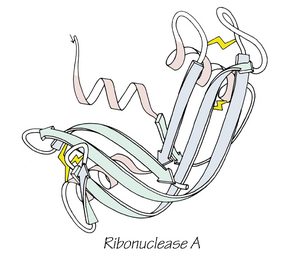Anfinsen's dogma facts for kids
Have you ever wondered how tiny parts inside your body know what shape to become? Proteins are like tiny machines that do many jobs in your body. For these machines to work, they need to fold into a very specific 3D shape. Anfinsen's dogma is a big idea in molecular biology. It says that a protein's shape is usually decided by its own building blocks. These building blocks are called amino acids. They are arranged in a specific order, like letters in a word. This order tells the protein how to fold itself correctly. However, this idea is not true for all proteins. Some proteins need special helpers called chaperones to fold properly.
What is Anfinsen's Dogma?
Christian Anfinsen was a scientist who came up with this idea. He won the Nobel Prize for Chemistry in 1972. He got the award for his work on an enzyme called ribonuclease A. Anfinsen's dogma suggests that a protein's final shape is its most stable one. It forms automatically under the right conditions.
This idea relies on three main points:
- Uniqueness: The protein's specific sequence of amino acids should only have one correct folded shape. There should be no other shapes that are just as good.
- Stability: Once the protein folds into its correct shape, it should stay that way. Small changes around it, like in temperature, should not make it change shape.
- Kinetical accessibility: The protein should be able to reach its final shape easily. It should not have to go through very complicated steps, like tying itself in knots.
The Protein Folding Puzzle
How proteins find their correct shape is a big puzzle for scientists. This area of study is called protein folding. A related idea is called Levinthal's paradox. This paradox points out a problem. It says that a protein has a huge number of possible ways it could fold. Even a small protein would take longer than the universe has existed to try every possible shape. This means proteins must have a faster way to find their correct shape. They don't just try every single option.
When the Dogma Doesn't Apply
Not all proteins follow Anfinsen's dogma perfectly. Some proteins are exceptions.
- Prions: These are special proteins that can fold into a different, stable shape. This different shape is not the normal one. When prions misfold, they can cause serious problems. For example, in Bovine spongiform encephalopathy (often called Mad Cow Disease), normal proteins change their shape. This causes a harmful buildup of material called amyloid.
- Other diseases: Other diseases like Alzheimer's disease and Parkinson's disease also involve proteins misfolding. In these cases, proteins don't fold correctly. Instead, they form clumps that can harm cells. This shows that sometimes proteins don't automatically find their perfect, stable shape.


